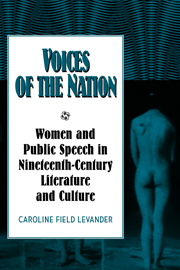Book contents
- Frontmatter
- Contents
- Acknowledgments
- Introduction: Gender, Speech, and Nineteenth-Century American Life
- 1 Bawdy Talk: The Politics of Women's Public Speech in Henry James's The Bostonians and Sarah J. Hale's The Lecturess
- 2 “Foul-Mouthed Women”: Disembodiment and Public Discourse in Herman Melville's Pierre and E. D. E. N. Southworth's The Fatal Marriage
- 3 Incarnate Words: Nativism, Nationalism, and the Female Body in Maria Monk's Awful Disclosures
- 4 Southern Oratory and the Slavery Debate in Caroline Lee Hentz's The Planter's Northern Bride and Harriet Jacobs's Incidents in the Life of a Slave Girl
- 5 Partners in Speech: Reforming Labor, Class, and the Working Woman's Body in Elizabeth Stuart Phelps's The Silent Partner
- 6 “Queer Trimmings”: Dressing, Cross-dressing, and Woman's Suffrage in Lillie Devereux Blake's Fettered for Life
- Conclusion: Women and Political Activism at the Turn into the Twentieth Century
- Notes
- Select Bibliography
- Index
- CAMBRIDGE STUDIES IN AMERICAN LITERATURE AND CULTURE
Introduction: Gender, Speech, and Nineteenth-Century American Life
Published online by Cambridge University Press: 27 October 2009
- Frontmatter
- Contents
- Acknowledgments
- Introduction: Gender, Speech, and Nineteenth-Century American Life
- 1 Bawdy Talk: The Politics of Women's Public Speech in Henry James's The Bostonians and Sarah J. Hale's The Lecturess
- 2 “Foul-Mouthed Women”: Disembodiment and Public Discourse in Herman Melville's Pierre and E. D. E. N. Southworth's The Fatal Marriage
- 3 Incarnate Words: Nativism, Nationalism, and the Female Body in Maria Monk's Awful Disclosures
- 4 Southern Oratory and the Slavery Debate in Caroline Lee Hentz's The Planter's Northern Bride and Harriet Jacobs's Incidents in the Life of a Slave Girl
- 5 Partners in Speech: Reforming Labor, Class, and the Working Woman's Body in Elizabeth Stuart Phelps's The Silent Partner
- 6 “Queer Trimmings”: Dressing, Cross-dressing, and Woman's Suffrage in Lillie Devereux Blake's Fettered for Life
- Conclusion: Women and Political Activism at the Turn into the Twentieth Century
- Notes
- Select Bibliography
- Index
- CAMBRIDGE STUDIES IN AMERICAN LITERATURE AND CULTURE
Summary
… the bright, up darting flame of her talk rose and fell like an improvisation on the keys … it's the voice, you know – the enchanting voice! … Its richness was quite independent of the words she might pronounce.
Henry James, The Tragic Muse (1890)She had a slow, quaint way of talking, that seemed a pleasant personal modification of some ancestral Yankee drawl, and her voice was low and cozy. … She never says anything you can remember; nothing in flashes or ripples … but [has] a sort of droll way of looking at things.
William Dean Howells, The Rise of Silas Lapham (1885)… her voice gave a curious charm to [his] old favorites when she read them; and many hours he listened contentedly to the voice whose youth made Montaigne's worldly wisdom seem the shrewder; whose music gave a certain sweetness to Voltaire's bitter wit … whose pitying wonder added pathos to the melancholy brilliancy of De Quincey.
Louisa May Alcott, A Modern Mephistopheles (1866)As in the three passages just quoted, the sound of women's speech is featured throughout the pages of nineteenth-century American fiction. Beginning with Charles Brockden Brown's Wieland (1798) and extending into the early twentieth century with F. Scott Fitzgerald's The Great Gatsby (1925), American novels devote much space to describing how women's voices sound and what reactions women's speech produces, especially in their male listeners.
- Type
- Chapter
- Information
- Voices of the NationWomen and Public Speech in Nineteenth-Century American Literature and Culture, pp. 1 - 11Publisher: Cambridge University PressPrint publication year: 1998



